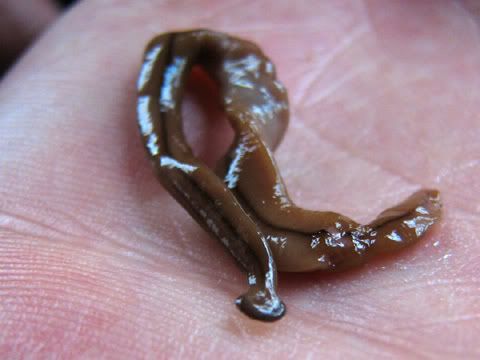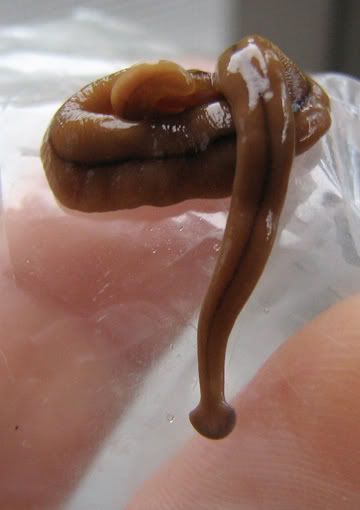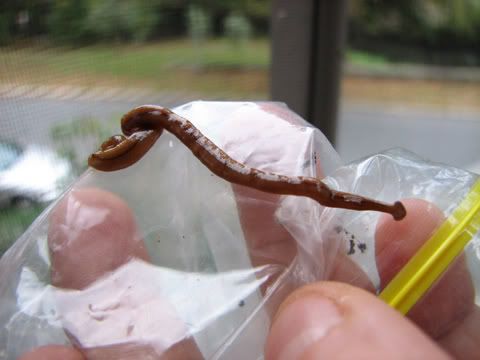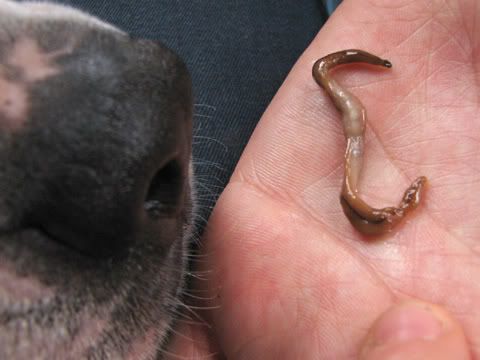365 Urban Species. #291: Terrestrial flatworm.

Photographs by cottonmanifesto.
Urban species #291: Terrestrial flatworm Bipalium adventitium
I'm making a more conjectural species identification this time than I usually do, if you can believe that. Bipalium adventitium is a species known to be in the United States from Illinois to New York, and spreading. I'm still waiting to hear from someone at the Harvard Museum of Comparative Zoology to see if an identification to species is even possible. This type of animal I have seen exactly three times, each time under debris in the wooded part of Olmsted Park in Boston. What's reasonably certain is that this is an exotic animal, most likely introduced inadvertently with tropical plants or soil from Southeast Asia or Indonesia. When the flatworm specialist comes back from vacation, hopefully these photographs along with the dead specimen pickled in 70% alcohol in a vial on my mantel, will provide enough information to positively verify it's taxonomy and origin.
Terrestrial flatworms are predatory animals, in the group Platyhelminthes, a phylum more well-known for its many parasitic members. Of course, painting the terrestrial flatworm with the same broad brush applied to the liver fluke or tapeworm is about as fair as condemning all vertebrates for their relation to the kandiru, the tiny catfish whose existence makes urinating while swimming in the Amazon ill advised. That said, it can't be described as a beautiful creature, unless one has an uncommonly agreeable attitude toward natural beauty. Flattened and flaccid, yet muscular and sluglike, secreting a thick sticky mucus, and, when disturbed, forever waving its mushy little hammerhead around, it's certainly distinctive. Unlike its more famous relatives that spend most of their lives inside the bodies of other animals, this creature and its ilk feed on earthworms, tackling prey many times their own size. A terrestrial flatworm introduced to Ireland from New Zealand (an island group usually on the short end of the "alien invasive" stick) is eating through the annelid fauna of the Emerald Isle at an alarming rate. The ecological damage to Ireland, its soil, its crops, and its natural landscape has yet to be fully calculated, but the situation is worrying. Whether this flatworm in Boston is a cause for distress or not, is something I hope to determine.




Dear Dr./Mr Taylor,
Thanks so much for your email. No need to wait for Harvard, the animal in the
photo is almost definitely Bipalium adventitium. My students and I have
continued to work with this species and its relatives. This species is now
found from coast to coast from VA to MA and CA to OR. Boston should be right
near the northern extent of its range.
We are currently studying the animals from both ecological and molecular
perspectives. We would welcome new live specimens for use in either behavioral
expermeints or on-going DNA sequencing. I would be happy to pay for the
shipping of a few individuals, but since this is not covered by any grants, I'm
trying to pay only for shipments of more than one individual. If you are
interested and have some to send, I'd be happy to send you directions for their
safe shipment.
If you'd like additional information about our work, I'd be happy to send copies
of some of our papers about these amazing beasts.
Thanks again for letting me know about your find. We are maintaining a database
on the distribution of these flatworms in North America.
Sincerely,
Pete Ducey
Department of Biological Sciences
State University of New York at Cortland
Cortland, NY 13045